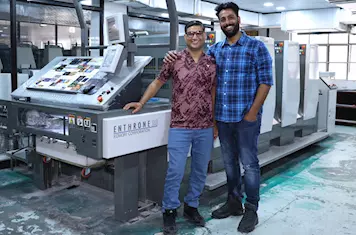5 Ways Printing Is Becoming More Sustainable
Components & Peripherals News
Dylan Martin
CRN examines five ways that printing can become more sustainable. From improved toner technologies and business changes, to forest restoration programmes and printer fleet right-sizing.

The printer industry has always been focused on sustainability. However, in recent years the drive to create environmentally friendly products has increased.
“More and more people are driving their buying decisions based on sustainability and sustainable practices,” said Sue Richards, the global head of home print hardware and quality at Palo Alto, Calif.-based HP Inc.
[Related: 6 Cool Printers Built For The Hybrid Work Era]
Due to the constant use of ink, toner and plastics or paper, printing is a material-intensive process. This has driven printer vendors to find different ways to reduce the environmental impact of such a high consumption of materials, including recycling programs, which have been a cornerstone of the industry’s sustainability efforts.
The industry is also looking at how to reduce energy consumption, whether that’s through improved technologies or right-sizing an organization’s printer fleet.
As part of CRN’s 2023 Printer Week, we take a look at five ways printing is becoming more sustainable, from improved toner technology and business changes to forest restoration programs and printer fleet right-sizing.
Improved Toner Technology for Laser Printers
Laser printer toner is an area that the industry is working on improving sustainability.
In March, HP Inc. announced a new toner technology called TerraJet, which the company said offers the “most sustainable and the highest performance office printing HP has ever achieved.” The latest HP Color LaserJet printers use Terrajet.
HP says that TerraJet can save up to 27 percent on energy, and up to 78% less plastic for packaging compared to other toner technologies. It also allows for up to 20% more color options, according to the company.
“It really gives our enterprise customers an option to really lean in to help contribute towards sustainable printing and sustainable practices in their enterprise,” said Richards, the global head of home print hardware and quality at HP.
Transitioning Customers To Inkjet Printers
Epson, rather than try to make laser printers sustainable, has decided to exit laser printers by 2026. The company will then direct customers to inkjet printers that use less energy, and are easier to manufacture and ship.
Epson announced its decision to stop selling laser printers last November and said the move stemmed from “laser technology’s limited ability to make significant steps towards improved sustainability due to its requirement for heat during the print process, and therefore increased energy use.”
According to the company, inkjets use less energy and high-yield cartridges to reduce material consumption and shipping.
Forest Conservation And Restoration Programs
Some printer companies try to offset the paper they use by investing in large-scale forest conservation programs.
This includes an $80 million pledge made by HP Inc. last year to support the World Wildlife Fund’s forest conservation efforts.
The company said the pledge “will address 17 million metric tons of paper used in both consumer and commercial HP printers over 10 years,” equivalent to “sustainably managing, restoring and protecting nearly 1 million acres of forest.”
“We want people to not be afraid to print but recognize that we are working with our partners to make sure that we’re doing forest restoration for the amount we consume,” said Richards, HP’s global head of home print hardware.
Epson, Xerox and Lexmark are among the other vendors who have invested in programs for forest conservation and restoration.
Right-Sizing Printer Fleets
The industry can reduce the environmental impact by helping organizations to right-size their fleets.
Printer vendors make this happen by assessing a customer’s existing fleet of printers and making recommendations about how to print more efficiently, for example by using fewer devices or updating the devices.
This assessment is typically offered as part a managed print service offering. It may be provided by either a vendor, or a channel partner.
“The assessment tool that we have can help with [sustainability] Compared to older devices, the power-saving mode of some of the newer ones can save you money. [printers] were not being used, they still consumed a lot of power,” said Shelly Radler, a senior product marketing manager at Brother International.
“A lot of the more recent [printer] will go into a deep sleep when you’re not using them,” she added.
Improving the Durability and Longevity of Printers
The improved durability and longevity can have a positive impact on the environment because they reduce the need to produce and transport additional devices.
“The most sustainable thing you can do is have printers that last a long time when they’re in an environment and not have to build new devices, not have to pull raw materials out of the earth to replace a device every three or four years, so designing products that last seven to 10 years is step one in that aspect,” said Chris White, executive director of global product strategy and product management at Lexmark.
Scott Dabice Vice President of Pricing and Strategic Markets at Ricoh USA, also shared this sentiment.
“With each of our new models that come out, we continually see a longer use of lifetime parts,” he said. “We have parts that used to have to be replaced every one or two years.” Now they last six or seven years, he added.

Dylan Martin


